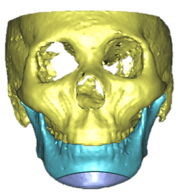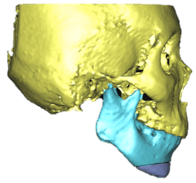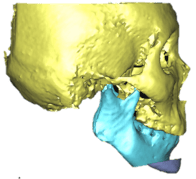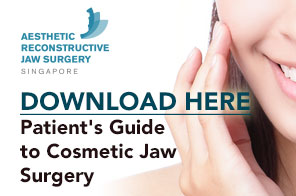Share this
Should I have a Chin Implant or a Genioplasty?
on August 3, 2016

Change of facial contour can be done by either shifting the facial bones around, i.e. orthognathic surgery, or by adding facial implants. What is actually done for a particular patient depends very much on which surgeon she sees.
In general, in Singapore, most plastic surgeons tend to opt for the chin implant while oral maxillofacial surgeons tend to gravitate towards genioplasty. So, which is the better option?
Genioplasty



Literally, this means changing the shape of the chin. This is the more invasive surgery compared with inserting a chin implant. The surgery can be done under local anesthesia with intravenous sedation on an outpatient basis though the majority of the time, general anesthesia is used in a day surgery setting.
The incision is made through the inside of the lower lip down to the bone level. The chin is then exposed and mental nerve on each side of the jaw bone is identified. The chin bone is then cut using a saw, starting from either the left or right side of the chin below and in front of the mental nerve and advanced to the opposing side.
The muscles that are attached to the detached chin is maintained to ensure an undisturbed blood supply. This segment is than repositioned into a more forward position and secured with a titanium plate and screws. The incision is then closed with sutures and a pressure bandage applied for two days.
Who are Good Candidates for Genioplasty?
Genioplasty, also known as chin surgery, is a cosmetic surgical procedure that involves reshaping or repositioning the chin. Good candidates for genioplasty include individuals who have:
- A weak or receding chin that makes the face appear unbalanced or disproportionate.
- An excessively prominent chin that creates an unbalanced facial profile.
- A chin that is too long or too short, causing facial asymmetry.
- A chin that is misaligned with the rest of the facial features.
- A desire to improve the overall appearance of the chin and facial profile.
It is important to note that genioplasty is a surgical procedure and should only be considered after a thorough consultation with a qualified surgeon who can evaluate your individual needs and determine if the procedure is appropriate for you.
Advantages of Genioplasty
One of the advantages of a genioplasty is that like any other orthognathic surgical procedures, simulation of the facial changes can be done preoperatively using computer software. The degree and direction of movement of the chin segment can be predicted to help the patient visualize what the probable result may look like.
Another advantage is that the result is stable as the bone heals very well and after remodeling, there is usually hardly any visible signs of surgery except for the fixation plate which can be removed if the patient so desire.
Furthermore, the shape of the chin can be changed in all directions. It can be reduced vertically and advanced horizontally, or vice versa. It can also be reduced in width, enhancing the V-ness of the lower jaw which is so popular nowadays.
Disadvantages of genioplasty
However, the major disadvantage is that it is fairly invasive as it requires the sawing of bone which may lead to significant bleeding. There is also a greater incidence of numbness of the lower lip and teeth due to the proximity of the bone cut to the mental nerves, which provided sensation to the lip. Postoperatively, the swelling can be significantly more than a chin implant.
Possible Risks and Complications of Genioplasty
While genioplasty can provide significant improvements in the appearance of the chin and facial profile, like any surgical procedure, it carries certain risks and potential complications. Below are some of the most common risks and complications associated with the procedure.
- Bleeding and Infection. Like any surgical procedure, bleeding and infection are potential risks of genioplasty. While the risk of bleeding during the procedure is relatively low, it can still occur, especially if the patient is taking blood thinners or has a bleeding disorder. Infection can also occur, although it is relatively rare and can be prevented with proper surgical techniques and postoperative care.
- Numbness and Tingling. Genioplasty involves making incisions in the chin and repositioning or reshaping the bone. As a result, there is a risk of nerve damage, which can lead to numbness or tingling in the chin, lower lip, or tongue. While these symptoms are usually temporary and resolve on their own within a few weeks or months, in rare cases, they can be permanent.
- Implant Displacement. In some cases, genioplasty involves the use of an implant to augment the chin. While these implants are designed to stay in place, there is a risk of displacement, especially in the first few weeks after surgery. If the implant shifts or moves, it may need to be repositioned or removed, which can require additional surgery.
- Scarring. Genioplasty involves making incisions in the chin, which can result in visible scarring. While surgeons use techniques to minimize scarring, some scarring is unavoidable, and the extent of scarring can vary depending on the patient's skin type and healing ability.
- Unsatisfactory Results. While genioplasty can provide significant improvements in the appearance of the chin and facial profile, there is always a risk that the patient may not be satisfied with the results. In some cases, additional surgery may be required to achieve the desired outcome.
Patients should discuss these risks with their surgeon and carefully weigh the benefits and risks before deciding to undergo genioplasty. Patients should also carefully follow their surgeon's postoperative instructions to minimize the risk of complications and ensure proper healing.
In addition to the risks and complications mentioned above, there are also some general risks associated with any surgical procedure, such as anesthesia-related risks, blood clots, and adverse reactions to medications. Patients should discuss these risks with their surgeon before the procedure and disclose any medical conditions or medications they are taking.
It is also important to have realistic expectations about the outcome of genioplasty. While the procedure can provide significant improvements in the appearance of the chin and facial profile, it is not a cure-all for all cosmetic concerns. Patients should discuss their goals and expectations with their surgeon and have a realistic understanding of what can be achieved with the procedure.
Chin Implant
Insertion of a chin implant is the same as a genioplasty up to the point where the gum is stripped from the bone. After this, instead of using a saw to cut the chin bone, the implant is adapted onto the surface of the chin bone and secured with titanium screws. The incision is stitched up in the same way and a pressure bandage applied.
Chin implants can be made of a porous material such as polyethylene, which integrates with the bone or silicone, which remains separate from the bone. Chin implants that integrate into the bone are permanent implants as they are extremely difficult to remove.
This is considered an advantage by some surgeons as it becomes like a part of the native bone. However, should complications such as infection arise, removal of the implant is difficult.
Silicone implants, however, do not integrate into the bone and can be removed easily if the patient desires. However, as it merely rest on the surface of the bone, it has a tendency to sink into the bone as the long term pressure on the surface of the chin causes bone to resorb. As the implant sinks in, it loses its projection and the chin may appear deficient again. The implant can be removed relatively easily and a new and larger implant can be placed.
Who are Good Candidates for Chin Implants?
While chin implants can provide significant improvements in the appearance of the chin and facial profile, they are not suitable for everyone. Below are some of the characteristics of good candidates for chin implants.
- Weak or Receding Chin. One of the most common reasons for chin implants is to correct a weak or receding chin. Good candidates for chin implants usually have a chin that is not well-defined and does not project forward enough to create a balanced facial profile.
- Facial Asymmetry. Chin implants can also be used to correct facial asymmetry. Good candidates for chin implants usually have a chin that is misaligned with the rest of their facial features, creating an unbalanced appearance.
- Good Overall Health. Like any surgical procedure, chin implants carry certain risks and potential complications. Good candidates for chin implants should be in good overall health and free of any medical conditions that may increase the risk of complications.
- Realistic Expectations. Good candidates for chin implants should have realistic expectations about the outcome of the procedure. While chin implants can provide significant improvements in the appearance of the chin and facial profile, they are not a cure-all for all cosmetic concerns.
- Non-Smokers. Smoking can increase the risk of complications during and after surgery. Good candidates for chin implants should be non-smokers or willing to quit smoking for a certain period of time before and after the procedure.
- Adequate Bone Structure. Chin implants require adequate bone structure to support the implant and achieve a natural-looking result. Good candidates for chin implants usually have enough bone structure to support the implant and achieve the desired outcome.
- Good Dental Health. Chin implants can affect the alignment of the teeth and jaw. Good candidates for chin implants should have good dental health and be free of any dental problems that may affect the outcome of the procedure.
Possible Risks and Complications of Chin Implant
Below are some of the most common risks and complications associated with chin implants.
- Infection. Like any surgical procedure, infection is a potential risk of chin implants. While the risk of infection is relatively low, it can occur and can be prevented with proper surgical techniques and postoperative care.
- Nerve Damage. Chin implants involve making incisions in the chin and inserting an implant, which can damage the nerves in the area. This can lead to numbness or tingling in the chin, lower lip, or tongue. While these symptoms are usually temporary and resolve on their own within a few weeks or months, in rare cases, they can be permanent.
- Implant Displacement. In some cases, chin implants can shift or move from their original position, especially in the first few weeks after surgery. If the implant shifts or moves, it may need to be repositioned or removed, which can require additional surgery.
- Scarring. Chin implants involve making incisions in the chin, which can result in visible scarring. While plastic surgeons use techniques to minimize scarring, some scarring is unavoidable, and the extent of scarring can vary depending on the patient's skin type and healing ability.
- Unsatisfactory Results. While chin implants can provide significant improvements in the appearance of the chin and facial profile, there is always a risk that the patient may not be satisfied with the results. In some cases, additional surgery may be required to achieve the desired outcome.
- Allergic Reaction. In rare cases, patients may have an allergic reaction to the implant material used in chin implants. Patients should inform their surgeon of any allergies they have before the procedure.
- Hematoma. Hematoma is a potential risk of any surgical procedure and involves the accumulation of blood under the skin. While the risk of hematoma is relatively low, it can occur and may require additional surgery to drain the blood.
So how does a patient decide which approach to adopt?
Chin implants can only be use to augment ie add to the bulk of the chin. If the chin requires reduction in size, chin implant has no role to play. As such, it depends very much on the treatment objective. Even among the chin augmentation cases, what is required maybe an augmentation in the horizontal direction which the implant can achieve, and a reduction in the width and/or height, which the implant cannot.
In cases where either approach is workable, age may play a role in influencing preference. Young patients, especially the orthognathic age group, generally opt for a genioplasty as it does not involve leaving a foreign object in the body for the rest of their lives. Older patient may opt for a chin implant due to the less invasive nature of the surgery and shorter downtime.
As with all surgeries, experience of the surgeon plays a big role in the outcome. Oral maxillofacial surgeons are generally more conversant with bony surgery and hence genioplasty is usually the preferred choice. Plastic surgeons are generally more comfortable with soft tissue surgery and may produce better results with implants.
Ultimately, the patient needs to understand what the different approaches entail and choose a surgeon that she is comfortable with. Chin surgery is primarily cosmetic in nature except in sleep apnea surgery where a chin advancement is medically indicated. Due to the subjectivity of aesthetics, a thorough discussion between the patient and surgeon is of utmost importance to achieve the aesthetic ideal that the patient has in mind.
Frequently Asked Questions
Both procedures serve to change the shape and size of the chin. A chin implant increases the dimensions of the chin as well as augment its shape. Genioplasty is a surgery that involves cutting and repositioning the chin in a different position to either increase or decrease the physical dimensions of the chin as well as its shape.
Initial recovery from the swelling takes about a week. There is usually some degree of numbness which may take a few months to a year to recover.
Genioplasty results lasts a lifetime once the chin bone has healed. The fixation plates that is used to hold the chin bone can be left in place for life though some patients opt to have them removed after a year. Chin implants that are made of material that are integrated into the bone similarly lasts a lifetime. However, some chin implants are made to be removable and they will typically lasts for about 10 years before needing to be replaced.
In the vast majority of cases, incision is done on the inside of the mouth, eliminating the need to make incisions on the skin which tend to leave scars. Intraoral incision scars are visible but only to the patient himself/herself. In some cases, e.g. for large chin implants, incision may be needed on the skin under the chin. Such incisions may leave visible scars but they are usually hidden from direct vision because they are placed below the jaw line.
A genioplasty should ideally be done in a hospital or an ambulatory surgery centre operating room under general anesthesia. Estimated cost range from S15000-20000. A chin implant can be done outpatient in the clinic setting under local anesthesia and intravenous sedation. However, there is the added cost of buying the implant. Estimated cost of surgical insertion of a chin implant ranges from $10000-15000.
If general anesthesia is used, there is totally no pain during the procedure, whether genioplasty or chin implant. With local anesthesia, some mild pain sensation may be felt in some cases but it is also generally pain free. Postoperatively, the pain is moderate and can be kept to a minimum by regular use of oral painkillers for the first few days.
Routine sedentary activities can be resumed one day after the surgery. Strenuous physical exercises should be avoided for a week. Contacts sports should not be played for at least six months post surgery.
Mild augmentation of the chin can be done by the use of dermal fillers.
Share this
- Jaw Surgery (93)
- Dental Implants Singapore (90)
- Orthognathic Surgery (48)
- Replacing Missing Teeth (26)
- Missing Teeth Options (23)
- Underbite (23)
- Bone Grafting (21)
- Costs (18)
- Facial Aesthetics (18)
- Aesthetics (17)
- dental implants (16)
- corrective jaw surgery (15)
- BOTOX (11)
- Dermal Fillers (11)
- Wisdom teeth (10)
- Fixed Implant Dentures (8)
- Loose Dentures Singapore (6)
- Medisave (6)
- sleep apnea (6)
- Braces (5)
- Dental Pain (5)
- Dentures in Singapore (5)
- Loose Teeth (5)
- Tooth Extraction (5)
- jaw deformities (5)
- bimax (4)
- bone graft (4)
- maxillomandibular advancement (4)
- all-on-4 (3)
- bimaxillary protrusion (3)
- chin implant (3)
- facial asymmetry (3)
- full mouth dental implants (3)
- genioplasty (3)
- immediate implant (3)
- removal of an integrated dental implant (3)
- third molars (3)
- wisdom tooth surgery (3)
- My Dentures Don't Fit (2)
- VME (2)
- bone graft healing (2)
- distraction osteogenesis (2)
- medical tourism (2)
- obstructive sleep apnea (2)
- orthodontics (2)
- plastic surgery (2)
- CT guided dental implants (1)
- Double jaw surgery (1)
- Invisalign (1)
- Periodontal Disease (1)
- Permanent Dentures Singapore (1)
- before and after photos (1)
- facial trauma (1)
- fractured dental implant (1)
- oral appliance therapy (1)
- root canal treatment (1)
- veneers (1)
- vertical maxillary excess (1)
- September 2019 (2)
- July 2019 (2)
- May 2019 (2)
- August 2018 (1)
- October 2017 (1)
- September 2017 (2)
- August 2017 (1)
- June 2017 (2)
- May 2017 (4)
- April 2017 (1)
- March 2017 (1)
- February 2017 (3)
- January 2017 (3)
- December 2016 (1)
- November 2016 (2)
- October 2016 (4)
- September 2016 (9)
- August 2016 (5)
- July 2016 (11)
- June 2016 (14)
- May 2016 (6)
- April 2016 (2)
- March 2016 (1)
- January 2016 (7)
- December 2015 (10)
- November 2015 (4)
- October 2015 (9)
- September 2015 (7)
- August 2015 (1)
- July 2015 (6)
- June 2015 (3)
- May 2015 (7)
- April 2015 (5)
- March 2015 (8)
- January 2015 (5)
- December 2014 (7)
- November 2014 (7)
- October 2014 (6)
- September 2014 (8)
- August 2014 (5)
- July 2014 (7)
- June 2014 (8)
- May 2014 (9)
- April 2014 (10)
- March 2014 (6)
- February 2014 (8)
- January 2014 (3)
Subscribe by email
Email subscription




Comments (2)